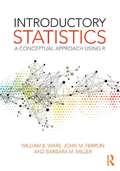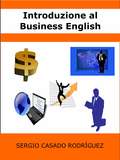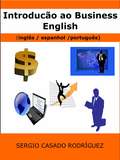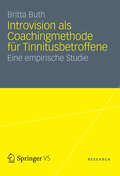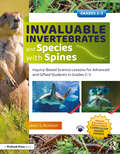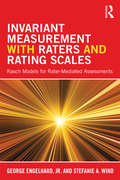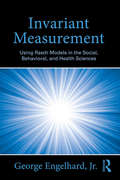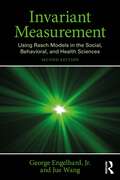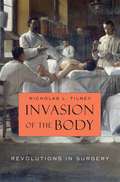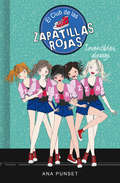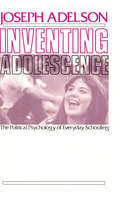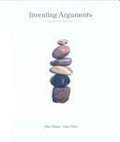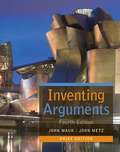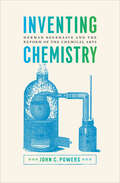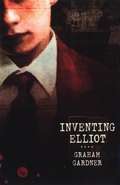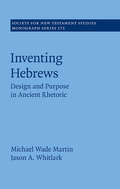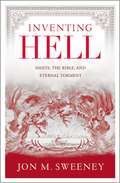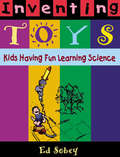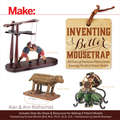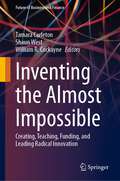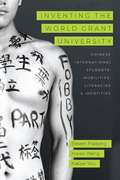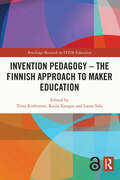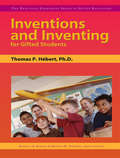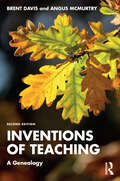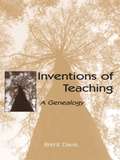- Table View
- List View
Introductory Statistics: A Conceptual Approach Using R
by William B. Ware John M. Ferron Barbara M. MillerThis comprehensive and uniquely organized text is aimed at undergraduate and graduate level statistics courses in education, psychology, and other social sciences. A conceptual approach, built around common issues and problems rather than statistical techniques, allows students to understand the conceptual nature of statistical procedures and to focus more on cases and examples of analysis. Wherever possible, presentations contain explanations of the underlying reasons behind a technique. Importantly, this is one of the first statistics texts in the social sciences using R as the principal statistical package. Key features include the following. Conceptual Focus – The focus throughout is more on conceptual understanding and attainment of statistical literacy and thinking than on learning a set of tools and procedures. Problems and Cases – Chapters and sections open with examples of situations related to the forthcoming issues, and major sections ends with a case study. For example, after the section on describing relationships between variables, there is a worked case that demonstrates the analyses, presents computer output, and leads the student through an interpretation of that output. Continuity of Examples – A master data set containing nearly all of the data used in the book’s examples is introduced at the beginning of the text. This ensures continuity in the examples used across the text. Companion Website – A companion website contains instructions on how to use R, SAS, and SPSS to solve the end-of-chapter exercises and offers additional exercises. Field Tested – The manuscript has been field tested for three years at two leading institutions.
Introduzione al Business English
by Sergio Casado Rodríguez Federico CasablancaEbook orientato a tutte quelle persone interessate a perfezionare il proprio inglese e introdursi i una delle sue varianti imprescindibili, l'inglese aziendale o Business English.
Introdução ao Business English (inglês/ espanhol / português)
by Sergio Casado Rodríguez Lourdes Vanessa BerthoudE-book trilingue (inglês/espanhol/português) orientado para todas as pessoas interessadas em aperfeiçoar seu inglês e se iniciar em uma de suas variantes mais imprescindíveis: o inglês para os negócios ou Business English.
Introvision als Coachingmethode für Tinnitusbetroffene
by Nicole Pereira GuedesBasierend auf der aktuellen Forschungslage zum Thema Tinnitus und der Coachingmethode Introvision, entwickelt Britta Buth ein theoretisches Modell, das die Chronifizierung eines Tinnitus darlegt. Auf dieser Grundlage wird ein von der Autorin konzipiertes Gruppen- und Einzelcoaching dargestellt und dessen Wirksamkeit empirisch überprüft. Die Ergebnisse zeigen, dass die Introvision als Interventionsmethode bei einem kompensierten chronischen Tinnitus effektiv und langfristig eine Verringerung der Belastung durch den Tinnitus und eine Reduzierung von Stress bewirkt.
Invaluable Invertebrates and Species with Spines: Inquiry-Based Science Lessons for Advanced and Gifted Students in Grades 2-3
by Jason S. McIntoshRecipient of the 2022 NAGC Curriculum AwardInspire the next generation of zoologists with this 30-lesson interdisciplinary science unit geared toward second and third grade high-ability students.Using problem-based learning scenarios, this book helps students develop the vocabulary, skills, and practices of zoologists as they conduct research and solve real world problems. Students will gain an in-depth understanding of how the animal kingdom is structured, create an innovative zoo exhibit containing an entire ecosystem for a vertebrate animal of their choosing, design invertebrate animal trading cards, and much, much more. Featuring detailed teacher instructions and reproducible handouts, this unit makes it easy for teachers to adjust the rigor of learning tasks based on students’ interests and needs.Aligned with Common Core State Standards for English Language Arts and Mathematics plus the Next Generation Science Standards, gifted and non-gifted teachers alike will find this expedition into the animal kingdom engaging, effective, and highly adaptable.
Invariant Measurement with Raters and Rating Scales: Rasch Models for Rater-Mediated Assessments
by Stefanie Wind George Engelhard Jr.The purpose of this book is to present methods for developing, evaluating and maintaining rater-mediated assessment systems. Rater-mediated assessments involve ratings that are assigned by raters to persons responding to constructed-response items (e.g., written essays and teacher portfolios) and other types of performance assessments. This book addresses the following topics: (1) introduction to the principles of invariant measurement, (2) application of the principles of invariant measurement to rater-mediated assessments, (3) description of the lens model for rater judgments, (4) integration of principles of invariant measurement with the lens model of cognitive processes of raters, (5) illustration of substantive and psychometric issues related to rater-mediated assessments in terms of validity, reliability, and fairness, and (6) discussion of theoretical and practical issues related to rater-mediated assessment systems. Invariant measurement is fast becoming the dominant paradigm for assessment systems around the world, and this book provides an invaluable resource for graduate students, measurement practitioners, substantive theorists in the human sciences, and other individuals interested in invariant measurement when judgments are obtained with rating scales.
Invariant Measurement: Using Rasch Models in the Social, Behavioral, and Health Sciences
by George Engelhard Jr.This introductory text describes the principles of invariant measurement, how invariant measurement can be achieved with Rasch models, and how to use invariant measurement to solve measurement problems in the social, behavioral, and health sciences. Rasch models are used throughout but a comparison of Rasch models to other item response theory (IRT) models is also provided. Written with students in mind, the manuscript was class tested to help maximize accessibility. Chapters open with an introduction and close with a summary and discussion. Numerous examples and exercises demonstrate the main issues addressed in each chapter. Key terms are defined when first introduced and in an end-of-text glossary. All of the book’s analyses were conducted with the Facets program. The data sets used in the book, sample syntax files for running the Facets program, Excel files for creating item and person response functions, links to related websites, and other material are available at www.GeorgeEngelhard.com. Highlights include: A strong philosophical and methodological approach to measurement in the human sciences Demonstrations of how measurement problems can be addressed using invariant measurement Practical illustrations of how to create and evaluate scales using invariant measurement A history of measurement based on test-score and scaling traditions Previously unpublished work in analyzing rating data, the detection and measurement of rater errors, and the evaluation of rater accuracy A review of estimation methods, model-data fit, indices used to evaluate the quality of rater-mediated assessments, rater error and bias, and rater accuracy. Intended as a supplementary text for graduate or advanced undergraduate courses on measurement or test theory, item response theory, scaling theory, psychometrics, advanced measurement techniques, research methods, or evaluation research taught in education, psychology, and the social and health sciences, the book also appeals to practitioners and researchers in these fields who develop or use scales and instruments. Only a basic mathematical level is required including a basic course in statistic.
Invariant Measurement: Using Rasch Models in the Social, Behavioral, and Health Sciences
by George Engelhard, Jr. Jue WangThis is the second edition of an introductory text that describes the principles of invariant measurement; how invariant measurement can be achieved using Rasch measurement theory; and how to use invariant measurement to solve a variety of measurement problems in the social, behavioral, and health sciences. Rasch models are used throughout the text, but brief comparisons of Rasch models to other item response theory (IRT) models are also provided.Written with students in mind, this new edition was class-tested to help maximize accessibility. Chapters open with an introduction and close with a discussion and summary. All chapters have been updated from the first edition, and a new chapter on explanatory Rasch models has been added. Features include numerous examples and exercises to demonstrate the main issues addressed in each chapter. Key terms are defined when first introduced and included in a helpful end-of-text glossary.This book also benefits from online materials which include the data sets used in the book, sample syntax files for running the Facets program, Excel files for creating item and person response functions, and links to related websites.This book will act as a supplementary text for graduate or advanced undergraduate courses on measurement or test theory, IRT, scaling theory, psychometrics, advanced measurement techniques, research methods, or evaluation research taught in education, psychology, and other social and health sciences. It will also appeal to practitioners and researchers in these fields who develop or use scales and instruments. Only a basic mathematical level is required, including a basic course in statistics, ensuring it is an accessible resource for students and researchers alike.
Invasion of the Body: Revolutions in Surgery
by Nicholas L. TilneyIn 1913, the Peter Bent Brigham Hospital in Boston admitted its first patient, Mary Agnes Turner, who suffered from varicose veins in her legs. The surgical treatment she received, under ether anesthesia, was the most advanced available at the time. At the same hospital fifty years later, Nicholas Tilney—then a second-year resident—assisted in the repair of a large aortic aneurysm. The cutting-edge diagnostic tools he used to evaluate the patient’s condition would soon be eclipsed by yet more sophisticated apparatus, including minimally invasive approaches and state-of-the-art imaging technology, which Tilney would draw on in pioneering organ transplant surgery and becoming one of its most distinguished practitioners. In Invasion of the Body, Tilney tells the story of modern surgery and the revolutions that have transformed the field: anesthesia, prevention of infection, professional standards of competency, pharmaceutical advances, and the present turmoil in medical education and health care reform. Tilney uses as his stage the famous Boston teaching hospital where he completed his residency and went on to practice (now called Brigham and Women's). His cast of characters includes clinicians, support staff, trainees, patients, families, and various applied scientists who push the revolutions forward. While lauding the innovations that have brought surgeons' capabilities to heights undreamed of even a few decades ago, Tilney also previews a challenging future, as new capacities to prolong life and restore health run headlong into unsustainable costs. The authoritative voice he brings to the ancient tradition of surgical invasion will be welcomed by patients, practitioners, and policymakers alike.
Invencibles, always (Serie El Club de las Zapatillas Rojas #Volumen 16)
by Ana Punset¡No te pierdas esta nueva aventura de las chicas de #ElClubDeLasZapatillasRojas! Celia ha decidido dejar su grupo de fotografía, pero sus antiguas compañeras no paran de dejarle comentarios en su cuenta de Instagram... ¡y no precisamente positivos! ¿Por qué tienen que comportarse así? Por suerte, sus amigas la están apoyando más que nunca. No hay ninguna duda: si están unidas, ¡son invencibles, always!
Inventing Adolescence: The Political Psychology of Everyday Schooling
by Joseph AdelsonThere is a widespread and deep awareness that all is not well with American public education nor with the students, educators, and administrators who are charged with making citizens literate. Joseph Adelson's work has gained considerable prominence in this ongoing reevaluation. Writing with force, verve, and the tools of advanced study, Adelson's book provides what might be the most comprehensive look at American education since the work of Diane Ravitch. The materials include revised and updated versions of essays that caused a real stir when they first appeared in the pages of Commentary, Daedalus, The American Scholar, and The Public Interest, among other places.The work goes against the grain of rhetoric but quite with the grain of the best in social science: That the erosion of trust in the American young has been far less severe than in the American old, that the degree of pathology, alienation, and rebelliousness in the American adolescent population is far from alarming. On the whole, each and every serious research study shows the vast majority of teenagers to be competent, purposeful, at ease with themselves, and closely bonded to their families and their values. This is, however, no pollyannish version of American education, but a tough-minded critique of educators and administrators who prefer ideological generalities to empirical truths, and whose vested interests are not in the requirements of learning, but ultimately in its subversion. The invention of adolescence was a search for a problem child more nearly detected in problematic adults.
Inventing Arguments (Second Edition)
by John Mauk John MetzThe text's prominent focus on invention teaches students to recognize the rhetorical elements of any argumentative situation and apply the tools of argument effectively in their own writing.
Inventing Arguments: Brief 4th Edition
by John Mauk John MetzOrganized around common rhetorical situations that occur all around us, INVENTING ARGUMENTS shows you that argument is a living process rather than a form to be modeled. Through the text's prominent focus on invention, you will learn to recognize the rhetorical elements of any argumentative situation and apply the tools of argument effectively in your own writing. The basic layers of argument are introduced in early chapters, with material arranged into increasingly sophisticated topics beginning with the most obvious or explicit layers (claims) and moving to more implied or "hidden" layers (assumptions, values, beliefs, ideology). By the time you finish Part 1, you will have a thorough understanding of argument, which you can then apply not just to the invention projects but also to your writing for other college courses and beyond.
Inventing Chemistry: Herman Boerhaave and the Reform of the Chemical Arts (Synthesis)
by John C. PowersThe story of this little-known Dutch physician &“will interest students and practitioners of history, chemistry, and philosophy of science&” (Choice). In Inventing Chemistry, historian John C. Powers turns his attention to Herman Boerhaave (1668–1738), a Dutch medical and chemical professor whose work reached a wide, educated audience and became the template for chemical knowledge in the eighteenth century. The primary focus of this study is Boerhaave&’s educational philosophy, and Powers traces its development from Boerhaave&’s early days as a student in Leiden through his publication of the Elementa chemiae in 1732. Powers reveals how Boerhaave restructured and reinterpreted various practices from diverse chemical traditions (including craft chemistry, Paracelsian medical chemistry, and alchemy), shaping them into a chemical course that conformed to the pedagogical and philosophical norms of Leiden University&’s medical faculty. In doing so, Boerhaave gave his chemistry a coherent organizational structure and philosophical foundation, and thus transformed an artisanal practice into an academic discipline. Inventing Chemistry is essential reading for historians of chemistry, medicine, and academic life.
Inventing Elliot
by Graham GardnerElliot, a victim of bullying, invents a calmer, cooler self when he changes schools in the middle of freshman year, but soon attracts the wrong kind of attention from the guardians who "maintain order" at the new school.
Inventing Hebrews: Design and Purpose in Ancient Rhetoric (Society for New Testament Studies Monograph Series #171)
by Michael Wade Martin Jason A. WhitlarkInventing Hebrews examines a perennial topic in the study of the Letter to the Hebrews, its structure and purpose. Michael Wade Martin and Jason A. Whitlark undertake at thorough synthesis of the ancient theory of invention and arrangement, providing a new account of Hebrews' design. The key to the speech's outline, the authors argue, is in its use of 'disjointed' arrangement, a template ubiquitous in antiquity but little discussed in modern biblical studies. This method of arrangement accounts for the long-observed pattern of alternating epideictic and deliberative units in Hebrews as blocks of narratio and argumentatiorespectively. Thus the 'letter' may be seen as a conventional speech arranged according to the expectations of ancient rhetoric (exordium, narratio, argumentatio, peroratio), with epideictic comparisons of old and new covenant representatives (narratio) repeatedly enlisted in amplification of what may be viewed as the central argument of the speech (argumentatio), the recurring deliberative summons for perseverance. Resolving a long-standing conundrum, this volume offers a hermeneutical tool necessary for interpreting Hebrews, as well as countless other speeches from Greco-Roman antiquity.
Inventing Hell
by Jon M. SweeneyHell: The word means terror, darkness, and eternal separation from God. Some people think the Bible is clear about hell, but what if they're mistaken? With gripping narrative and solid scholarship, Sweeney charts hell's "evolution" from the Old Testament underworld Sheol, through history and literature, to the greatest influencer of all: Dante's Inferno. He reveals how the modern idea of hell is based mostly on Dante's imaginative genius-but in the process, he offers a more constructive understanding of the afterlife than ever before. Disturbing and enthralling, Sweeney will forever alter what we think happens to us after we die-and more importantly, he will make us reconsider how we live. Bible really says about heaven and hell, giving us a clearer, more hopeful understanding of the afterlife than ever before.
Inventing Toys: Kids Having Fun Learning Science
by Ed SobeyAn intriguing combination of invention and toy making, this guide encourages students to work in teams to design and fabricate working toys while learning the fundamentals of science, design, tool usage, and the creative process. Toys range from cars to electric fans to rockets, and the trial-and-error process that students use to build these toys allows them to refine their models through experimentation--building, conducting tests, collecting and interpreting data, and making changes or improvements to their inventions. There are directions for seven workshops and suggestions for five more, and the science concepts and historical background involved in each project are explained for teachers.
Inventing a Better Mousetrap: 200 Years of American History in the Amazing World of Patent Models
by Ann Rothschild Alan RothschildLearn about the role that patent models played in American history--and even learn to build your own replica!Patent models, working models required for US patent filings from 1790 to 1880, offer insight into--and inspiration from--a period of intense technological advancement, the Industrial Revolution. The Rothschild Patent Model Collection consists of thousands of patent models, many from the 19th century. This book features the most outstanding of these patent models, and offers deep insight into the cultural, economic, and political history of the United States.This book not only catalogs hundreds of the most compelling models from the collection, but shows you how to build your own replicas of several selected models using Lego, 3D printing, and other materials and techniques.
Inventing the Almost Impossible: Creating, Teaching, Funding, and Leading Radical Innovation (Future of Business and Finance)
by Tamara Carleton Shaun West William R. CockayneLooking to pioneer scientific and technological breakthroughs that create entirely new industries? This book serves as your guide. It goes beyond patents, diving deep into the intersection of foresight, engineering, and business. Explore how teams at renowned organizations such as ARPA-E, IKEA, and H2 Green Steel create radical innovation. Through critical analysis, industry case studies, and teaching examples, an international and interdisciplinary group of scholars, practitioners, and mavericks offer practical advice for bringing visionary development to life. Whether you're seeking to invent the seemingly impossible or solve problems for which no market exists yet, this book renews the research agenda for the deliberate study of invention. It will inspire and provoke you to expand your thinking and push boundaries.
Inventing the World Grant University: Chinese International Students’ Mobilities, Literacies, and Identities
by Xiaoye You Steven Fraiberg Xiqiao WangThrough an exploration of the literacy practices of undergraduate Chinese international students in the United States and China, Inventing the World Grant University demonstrates the ways in which literacies, mobilities, and transnational identities are constructed and enacted across institutional and geographic borders. Steven Fraiberg, Xiqiao Wang, and Xiaoye You develop a mobile literacies framework for studying undergraduate Chinese international students enrolling at Western institutions, whose numbers have increased in recent years. Focusing on the literacy practices of these students at Michigan State University and at Sinoway International Education Summer School in China, Fraiberg, Wang, and You draw on a range of mobile methods to map the travel of languages, identities, ideologies, pedagogies, literacies, and underground economies across continents. Case studies of administrators’, teachers’, and students’ everyday literacy practices provide insight into the material and social structures shaping and shaped by a globalizing educational landscape. Advocating an expansion of focus from translingualism to transliteracy and from single-site analyses to multi-site approaches, this volume situates local classroom practices in the context of the world grant university. Inventing the World Grant University contributes to scholarship in mobility, literacy, spatial theory, transnationalism, and disciplinary enculturation. It further offers insight into the opportunities and challenges of enacting culturally relevant pedagogies.
Invention Pedagogy – The Finnish Approach to Maker Education (Routledge Research in STEM Education)
by Tiina Korhonen Kaiju Kangas Laura SaloThis collection, edited and written by the leading scholars and experts of innovation and maker education in Finland, introduces invention pedagogy, a research-based Finnish approach for teaching and learning through multidisciplinary, creative design and making processes in formal school settings. The book outlines the background of, and need for, invention pedagogy, providing various perspectives for designing and orchestrating the invention process while discusses what can be learnt and how learning happens through inventing. In addition, the book introduces the transformative, school-level innovator agency needed for developing whole schools as innovative communities. Featuring informative case study examples, the volume explores the theoretical, pedagogical, and methodological implications for the research and practice of invention pedagogy in order to further the field and bring new perspectives, providing a new vision for schools for decades to come. Intermixing the results of cutting-edge research and best practice within STEAM-education and invention pedagogy, this book will be essential reading for researchers, students, and scholars of design and technology education, STEM education, teacher education, and learning sciences more broadly.
Inventions and Inventing for Gifted Students
by Thomas P. Hébert Kristen Stephens Frances KarnesInventing involves creativity applied to a problem-solving process, which can be taught. Through teaching instructional units on inventing, multiple creative skills are infused into one unit. Teachers who provide their students with such instruction see inventions as a natural way of packaging creativity training in an authentic and meaningful way. Applying creative thinking skills and a knowledge of a field of study to create exciting inventions is at the heart of the inventing process. This guide offers a practical introduction to the inventing process: getting students interesting in inventing, teaching the inventing process, patenting new product ideas, participating in inventions conventions and competitions, and an extensive listing of print and Web-based resources. This is one of the books in Prufrock Press' popular Practical Strategies Series in Gifted Education. This series offers a unique collection of tightly focused books that provide a concise, practical introduction to important topics concerning the education of gifted children. The guides offer a perfect beginner's introduction to key information about gifted and talented education.
Inventions of Teaching: A Genealogy
by Brent Davis Angus McMurtryThis updated edition of Inventions of Teaching: A Genealogy presents an examination of the many and varied metaphors of teaching in English. These metaphors serve as sites to excavate conflicting historical, con-ceptual, and philosophical influences that have contributed to modern teaching practices.Though the Eurocentric perspectives of the first edition remain a focus, they are placed in a broader context that acknowledges their, as the authors coin it, ‘WEIRDness’ (i.e., western, educated, industrialized, rich, democratic nature). In this revised and expanded edition, these perspectives are accompanied by multiple case studies of non-Western and Indigenous educational traditions. Chapter discussions are organized as a genealogy around key conceptual bifurcations in thought rather than case-by-case analysis or a chronology. This structure allows the authors to examine the origins of distinctions that are often taken for granted, such as cognitivism vs. behaviorism, or constructivism vs. positivism. The genealogy develops around breaks in opinion that gave or are giving rise to diverse interpretations of knowledge, learning, and teaching--highlighting historical moments in which vibrant new figurative understandings of teaching emerged. A new chapter has been added, addressing the habits of interpretation needed to render the ‘WEIRD’ world sensible; alongside a much elaborated closing discussion, intended to bring WEIRD inventions of teaching into sharper relief by contrasting them with non-WEIRD cultures and some of their approaches to teaching.Inventions of Teaching: A Genealogy is an informative text for senior undergraduate and graduate courses in curriculum studies and foundations of teaching, It is also relevant for students, faculty, and researchers across the field of education who want to explore the consequences of diversities of opinion, belief, and practice concerning teaching and closely related topics of learning, knowing and formal education.
Inventions of Teaching: A Genealogy
by Brent DavisInventions of Teaching: A Genealogy is a powerful examination of current metaphors for and synonyms of teaching. It offers an account of the varied and conflicting influences and conceptual commitments that have contributed to contemporary vocabularies--and that are in some ways maintained by those vocabularies, in spite of inconsistencies and incompatibilities among popular terms. The concern that frames the book is how speakers of English invented (in the original sense of the word, "came upon") our current vocabularies for teaching. Conceptually, this book is unique in the educational literature. As a whole, it presents an overview of the major underlying philosophical and ideological concepts and traditions related to knowledge, learning, and teaching in the Western world, concisely introducing readers to the central historical and contemporary discourses that shape current discussions and beliefs in the field. Because the organization of historical, philosophical, theoretical, and etymological information is around key conceptual divergences in Western thought rather than any sort of chronology, this text is not a linear history, but several histories--or, more precisely, it is a genealogy. Specifically, it is developed around breaks in opinion that gave or are giving rise to diverse interpretations of knowledge, learning, and teaching--highlighting historical moments in which vibrant new figurative understandings of teaching emerged and moments at which they froze into literalness. The book is composed of two sorts of chapters, "branching" and "teaching." Branching chapters include an opening treatment of the break in opinion, separate discussions of each branch, and a summary of the common assumptions and shared histories of the two branches. Teaching chapters offer brief etymological histories and some of the practical implications of the terms for teaching that were coined, co-opted, or redefined within the various traditions. Inventions of Teaching: A Genealogy is an essential text for senior undergraduate and graduate courses in curriculum studies and foundations of teaching and is highly relevant as well for students, faculty, and researchers across the field of education.
